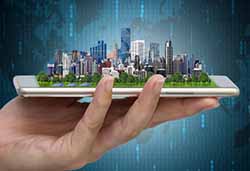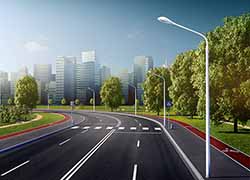The era in which “Smart City” is connoted for the future is long gone. Smart cities are now a reality and continue to gain popularity. Given the world’s rapid population growth, there is an increased demand for cutting-edge technologies that can aid in energy conservation. Government initiatives like “Smart City Mission” and “Digital India” continue to raise awareness about implementing smart solutions. The rise of the Internet of Things (IoT), which has a significant impact on the services provided by public corporations all over the world, is closely correlated with the growth of smart cities. Smart cities strive to excel in governance, economy, transport, environment, and efficient resource- use to enhance the lives of the residents and make urban living sustainable. Smart cities essentially represent the idea of an ecosystem, wherein each component is interconnected to create a unified, desirable package. As they coexist with urban facilities, smart cities present a range of new services that have an impact on urban policy-making and planning. The smart city framework also offers numerous options for city planners to contribute to urban life.

The Internet of Things (IoT) is transforming all industries, including outdoor lighting. Street lighting is becoming a part of a networked urban infrastructure rather than an isolated sphere. LED luminaires are now connected to a network and centrally controlled with the help of smart and connected lighting systems. This “smartification” enables the ability to illuminate different urban areas, including city centers, residential streets, tunnels, parks, etc., as per their specific lighting needs.

Today’s world is fueled by innovation and velocity. You can obtain anything you desire in a matter of minutes. Hungry? You can order meals and have them brought to you in a matter of minutes. Want to broaden your knowledge? You can get all the information you require online. The same idea also applies to smart appliances and home design. People can now remotely access their home’s atmosphere as well as customize it to suit their mood.

Tech-savvy customers nowadays are well aware of the latest innovations and prepared to invest in connected home solutions that can improve and enhance their lives. In fact, today many connected devices are present in every household, not just high-end homes and apartments. The need to be able to perform any task from any location has boosted the Indian market for IoT consumer appliances. Majority of household appliances now support IoT technology. Some equipment, such as chimneys, speakers, and water purifiers, can be controlled remotely at any time and from anywhere by using a smartphone or voice commands with Google Assistant or Alexa.
Today’s smart home appliances go beyond just buzzwords or marketing speak for the tech industry. Smart appliances are those that are Bluetooth or Internet-connected and could be remotely controlled or observed via a smartphone, tablet, or other devices. Modern lifestyles and rapid technological advancements are predicted to accelerate the adoption of intelligent appliances in homes. The Smart Homes of India report from market research firm TechARC found that 92% of all consumers who own a connected device, such as a smart lamp, smart speaker, or smart television, utilise speech functions to “talk” to these gadgets. As manufacturers began selling connected devices like smart lamps, plugs, televisions, and speakers at progressively lower rates, the adoption of smart technologies has increased.
Consumers today have begun incorporating new technology into their daily lives and are willing to embrace change. According to a recent survey, Indians use their phones for roughly five hours each day, and the country has the second-highest app interaction worldwide. More people are using smartphones for a variety of purposes, and today consumers are able to operate all household appliances and other gadgets with just a touch. The consumer appliances business will continue to bring innovative methods to integrate its products into the lives of modern residents as our nation continues to embrace the digital world.
Technology-based lighting solutions in smart cities provide many benefits, including centralised monitoring and management, easy and quick maintenance, power savings, increased dependability, and higher system efficiency. Due to its connection to a single network, the lighting system will have access to specific data on the overall amount of electricity used by each light or even the amount used by a particular phase. As a result, the issue of electricity theft can be easily resolved, and proactive maintenance will be made possible because it will be easier to identify any network leaks and take the appropriate action right away.
The majority of consumers have switched to smart lighting solutions due to rising disposable incomes and affordable internet connectivity. The recent pandemic has also given this segment a significant boost by redefining the function of our houses. Consumers are now aware of how connected devices can enhance their quality of life at home. They use smart lights to add a variety of colour to their homes and establish schedules to automate the lighting based on their lifestyle. Another intriguing point is that LED lights, which consume 75% less electricity than incandescent, halogen, and compact fluorescent lamps, are used in smart lighting (CFLs). As a result, they become energy-efficient which also reduces costs. Smart lighting can be turned off easily using an app because it can be controlled remotely. When there is natural light in the room, the brightness can be adjusted automatically with the use of motion sensors.
Smart street lights and poles provide multiple purposes in a smart city than just providing illumination. Additionally, street lighting poles can be utilized as data stations with sensors for adaptive lighting, weather and pollution sensing and surveillance, Wi-Fi and RF communication, smart screens for advertisements, public address systems, parking space monitoring, and electric vehicle battery charging. The risk of any harm will be reduced as cities expand owing to a security system of sensors and cameras. A system like this can operate directly over the city’s grid of centralised street lighting, enhancing the standard of living there. Both smart cities and smart technology will become more integrated as they grow together. By leveraging big data and other intelligent technology, better decision-making can improve city infrastructure. Of course, making better decisions could have a big impact on society. By focusing on the future, we will not only work to improve how we interact with our environment but also how cities interact with us, ensuring that we take advantage of the best opportunities without squandering scarce resources.
About The Author :

Mr. Gurumukh Uttamchandani
Executive Director,
Syska












